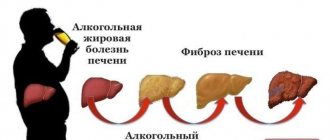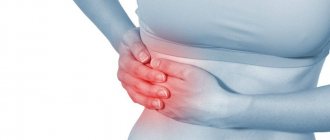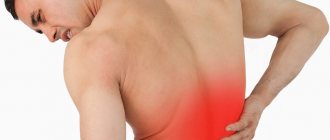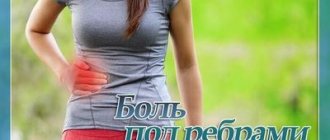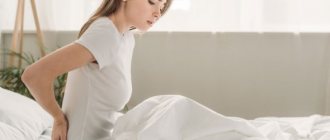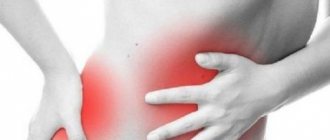Back pain during menstruation bothers approximately 40% of women of reproductive age (from 16 to 45 years). It can be of moderate or high intensity, occur a few days before or during menstruation, and can also be localized, radiating or reflected. The main location of back pain that occurs during menstruation is the lumbosacral spine (lower back), consisting of five lumbar and five sacral vertebrae. In some cases, the cause of the pain syndrome is the physiological changes that occur in a woman’s body during menstruation, but sometimes such pain can indicate various diseases of the genitourinary and reproductive systems, as well as chronic pathologies of the spine, aggravated during menstruation under the influence of certain hormones.
Back pain during menstruation
Normal or pathological?
Menstruation is a cyclic bleeding from a woman’s vaginal tract, which is the initial phase of the menstrual (reproductive) cycle. Pain of varying intensity during menstruation bothers more than 70% of women, but it is localized mainly in the lower abdomen and is associated with intense contraction of the uterus.
Phases of the menstrual cycle
The uterus is a muscular organ, pear-shaped and lined from the inside with endometrium - a mucous (functional) membrane that produces hormones and is abundantly supplied with blood vessels and capillaries.
Structure of the uterine wall
During menstruation, the endometrium is torn away from the body of the uterus and is excreted in the form of menstrual fluid, which also contains enzymes, salts and secretions secreted by the endocrine glands of the vagina and cervix. In order for the endometrial tissue to be able to exit into the vaginal tract, the uterus actively contracts, which provokes a nagging pain in the lower abdomen, which usually occurs 1-2 days before the onset of discharge.
Back pain (mainly in the lower back) can conditionally be considered normal, since it can also appear under the influence of natural physiological changes in the female body.
If you want to learn in more detail how to treat aching lower back pain, and also consider the causes, diagnosis and alternative treatment methods, you can read an article about this on our portal.
Back pain may be normal
In cases where painful sensations cause severe discomfort, are of high intensity or are accompanied by other alarming symptoms (for example, fever or urinary dysfunction), you should consult a local gynecologist, since some chronic diseases of the musculoskeletal system are aggravated during menstruation in women with unstable hormonal levels.
If the pain causes severe discomfort, you should consult a gynecologist.
Normal causes of back pain during menstruation include:
- increased synthesis of prostaglandins (sex hormones that regulate the reproductive cycle of women), increasing susceptibility to the main mediators of pain - histamine and bradykinin;
- anatomical features of the structure of the uterus (for example, the location of the uterus closer to the spine or bending towards the spinal column);
- overstrain of the lumbar region caused by sedentary work or physical activity;
- swelling of the pelvic organs caused by natural fluid retention in the body during menstruation.
During menstruation, women are advised to maintain emotional peace, since any stress and nervous tension can provoke increased pain in both the lower abdomen and back. With chronic stress, women may experience all types of menstrual pain, including headaches.
Pain in the back, lower abdomen, headaches can be a consequence of stressful conditions
Inflammation of the appendix
Acute or chronic appendicitis occurs at any age, but is more common in people between 10 and 30 years of age. The main causes of inflammation of the appendix of the cecum are solid impurities in food (seeds, husks), and less often - bacterial infection.
Symptoms of appendicitis:
- pain in the right side of the abdomen at or below the waist;
- loss of appetite;
- nausea, vomiting;
- elevated body temperature (optional).
Read about other symptoms here.
Important! Appendicitis is dangerous due to perforation of the walls and release of intestinal contents into the abdominal cavity, which leads to peritonitis. There is a risk of infection spreading in the body (sepsis).
"Cunning" of appendicitis:
- the symptoms of the disease may be the same as with inflammation of the gallbladder;
- pain in the upper abdomen on the right under the ribs, migrates to the navel;
- Uncharacteristic symptoms often occur, such as drowsiness;
- inflammation and pain are mild in older people;
- Pain in pregnant women occurs in the back and upper abdomen.
In most cases of inflammation of the appendix, surgery is performed to avoid dangerous complications. An appendectomy is performed under local anesthesia. If it is unknown why it hurts in the right side, and there is a suspicion of appendicitis, then you should not take analgesics so as not to complicate the diagnosis of the disease. You should definitely seek medical help.
Increased salt intake is one of the reasons
Salt (sodium chloride) is vital for the normal functioning of the entire body. Salt components (in particular, chloride ions) are the main component of hydrochloric acid, produced by the parietal cells of the stomach and necessary for normal digestion of food. Salt also ensures the functioning of the nervous system by participating in the transmission of nerve impulses and helps improve the nutrition of muscle tissue.
Table salt should not be consumed in large quantities, as it causes fluid retention in the body.
During menstruation, fluid can accumulate in the subcutaneous fatty tissue of the pelvic organs, and increased consumption of salty, smoked and pickled foods can increase tissue swelling and cause acute or aching pain in the lumbar and tailbone areas.
Pathologies of the uterus and their connection with lumbar pain
Some anatomical features of the uterus can cause back pain during menstruation. As a rule, such pain is combined with intense pain in the lower abdomen and lasts until the cessation of menstruation.
Pathologies and abnormalities of the uterus that can cause back pain during menstruation
| Pathology | What is it (features)? |
| With this pathology, the uterus does not have the shape of a pear, but the shape of horns (the organ cavity is divided into two oblong zones). In order for complete rejection of the mucosal layer to occur during menstruation, the uterus needs to contract with redoubled force, which leads to severe pain that can radiate to the tailbone, sacrum and lower back. |
| This is an anomaly of sexual development in which the uterus does not reach the age norm (in nulliparous women, the organ weighs about 50 g and has a length of 7-8 cm). Menstruation in such women is usually scanty and short-lived, but pain caused by increased synthesis of prostaglandins is most often concentrated not in the lower abdomen, but in the lumbar region. |
| This is a congenital pathology that forms as early as 19-20 weeks of embryonic development (it is at this stage of gestation that the septum is destroyed and a single cavity is formed). A distinctive feature of pain with this anomaly is localization on only one side, that is, a woman can clearly show where exactly the pain syndrome occurs. |
Note! Any diseases of the uterus (including infectious and inflammatory processes) can cause referred pain in the lumbar region. An alarming symptom is a combination of severe back pain with vaginal discharge that is not typical for the menstrual period (bad-smelling, purulent, interspersed with sediment): such discharge may be one of the signs of cervical cancer, so if it appears, you should immediately consult a doctor.
Infectious pathologies of the pelvic organs
Pain syndrome that occurs in the lower segment of the spine may be a consequence of infectious diseases of the pelvic organs related to the excretory and reproductive systems, for example, cystitis or salpingoophoritis (referred pain). During menstruation, the most significant factor in the development of infectious and inflammatory pathologies of the pelvic organs is non-compliance with intimate hygiene, so women need to be especially careful about the cleanliness of the genital organs and anorectal space.
Back pain (referred) with infectious pathologies of the pelvis
| Disease | Localization of the infectious and inflammatory process | Possible additional symptoms |
| Uterine appendages (fallopian tubes and ovaries). | Acute, burning or dagger-shaped pain in the lumbar region, predominantly on one side (the severe form is acute bilateral inflammation), pain during lifting heavy objects and sexual intercourse. Chronic inflammation is manifested by moderate pain, intermenstrual bleeding, moderate hyperthermia, and general weakness. |
| Bladder. | Impaired urination (pain, decreased daily diuresis, burning after urination), cloudy urine, sediment in the urine, increased temperature, deterioration in general health. |
| Tuberculosis of the genitourinary system | Urinary tract, urethra, bladder. | All the symptoms of infectious cystitis are characteristic, but in a more intense form. |
| Functional (mucosal) lining of the uterus. | Hyperthermia (up to 39°C), severe pain in the lower back and lower abdomen. It is possible that pus may appear in menstrual fluid. The uterus is tense and painful (determined by palpation). |
How to relieve pain?
Regardless of the cause of pain, the main way to eliminate it is drugs from the group of non-narcotic analgesics, for example, drugs based on metamizole sodium (Baralgin, Analgin).
"Baralgin"
Metamizole sodium should be taken no more than 2-3 times a day in a single dosage of 500 mg. Despite the effectiveness of Analgin in the treatment of acute pain syndromes of various etiologies and localizations, this drug is used less and less in medical practice due to the high risk of side effects and negative consequences caused by the high toxicity of metamizole sodium.
"Analgin"
Experts consider drugs from the anilides group, for example, Paracetamol, to be the drugs of choice for reducing menstrual pain in the back and abdomen.
"Paracetamol"
It is necessary to take paracetamol and its analogues (Panadol, Efferalgan) 500-1000 mg up to 3-4 times a day. If paracetamol is ineffective, you can use drugs from the NSAID group: Ibuprofen, Diclofenac, Movalis, Ketorolac.
"Ketorolac"
The duration of taking non-steroidal anti-inflammatory drugs without consulting a doctor should not exceed 5 days.
To reduce muscle tone, relieve spasms and reduce the strength of uterine contractions, which can provoke pain in the lower back, the use of antispasmodics is indicated. The most effective and safe for women during menstruation are:
- drotaverine (“No-shpa”, “Spazmol”, “Spazmonet”) - 20-40 mg up to 4 times a day;
"No-shpa" - papaverine hydrochloride 1% (“Papaverine”, “Papazol”, “Andipal”) - 1 suppository 2-3 times a day after bowel cleansing or bowel movements.
"Papaverine"
Further therapy is selected taking into account the results of diagnosis and medical examination. For infectious diseases of the pelvic organs or spine, antibiotics (Amoxicillin, Tetracycline, Hemomycin) and antimicrobial agents with antiprotozoal activity (Metronidazole) are prescribed.
Diverticulitis
The disease is accompanied by the formation of diverticula in the intestinal wall and inflammation of these bulges. If there are multiple non-inflamed growths, they speak of diverticulosis. If the process is accompanied by inflammation, the disease is called diverticulitis. Pain in 90-95% of patients is felt in the descending branch of the large intestine - above or below the navel, on one side or on both sides. In addition to pain, inflammation of the diverticulum is characterized by other symptoms: high fever, flatulence and constipation.
Whether a patient with diverticulitis can do without surgery should be asked by the attending physician. At home, they practice fasting days and consume more liquid food. When the acute stage has passed, you can switch to eating foods rich in fiber. You can ask your doctor how to relieve the pain. Doctors usually prescribe antibiotics and non-narcotic analgesics. If a rupture of the intestinal wall occurs, surgical removal of the damaged area is performed.
Treatment of back pain without drugs
In cases where pain in the lumbosacral, coccygeal segment or in another part of the back is the result of natural physiological processes occurring in the body at the beginning of the menstrual cycle, it can be dealt with without the use of medications.
Wool belt
A belt made from dog or goat hair is the safest and most effective way to combat back pain. More aggressive thermal effects (for example, heat applications, baths, saunas) are prohibited during menstruation, and the belt can be used with virtually no restrictions. It should be worn throughout the day, and in case of severe pain, the product should be left overnight (at least 8 hours).
Dog hair belt
Note! Some people advise rubbing your lower back with vodka or alcohol before putting on the belt. Experts do not advise doing this, since ethanol easily penetrates the skin (especially under the influence of heat, when the pores open more), which can cause intoxication in women with weakened immune systems.
Badger fat ointment
Badger fat is a very effective analgesic and anti-inflammatory agent that is used in folk and traditional medicine to treat coughs. Badger fat also stimulates blood flow to the application site, which has a positive effect on blood circulation and nutrition of the cartilage tissue that makes up the intervertebral discs. You need to apply the ointment 2-3 times a day (it is better to immediately wrap your lower back with a down scarf after this).
Badger fat
Advice! For chronic pelvic pain, which intensifies during menstruation, you can mix badger fat with natural honey (1 teaspoon each), heat the resulting mixture and apply a thick layer to the lumbar and tailbone area. Cover the top with a warm scarf and leave for 1-2 hours. After the procedure, rinse the skin thoroughly. To improve your well-being, it is enough to do 4-5 procedures.
Badger fat with honey
Gymnastics (exercise with a roller)
Heavy and intense physical activity during menstruation is contraindicated, but if a woman is bothered by back pain, it is recommended to perform this exercise daily (see picture below). It will not only relieve pain and discomfort, but also improve blood flow to the pelvic organs, and also increase the flexibility and elasticity of the spine.
Exercise to relieve back pain
If you don’t have a special gymnastic roller at home, you can make one from a terry towel. You should remain in this position for about 1 minute, gradually increasing the time to 2-3 minutes. If you perform this exercise daily, after a month you can forget about pain in the lumbar region.
Causes of pain
Pain can be triggered by various factors: heavy loads, exhausting workouts, excessive physical activity, colds, stress. If these phenomena become the causes of menstrual irregularities, then it is not difficult to eliminate the problem, the main thing is to contact a specialist in time.
The moment of pain onset is an important factor in diagnosing cycle disorders. According to the time of appearance, unpleasant painful sensations are divided into primary and secondary.
Primary ones occur immediately after the first menstruation or up to 1.5 years after that. Rarely, the causes of this phenomenon are pathologies or abnormalities in the genital organs; much more often, pain is provoked by disruption of processes in the nervous and endocrine system.
Primary pain can be caused by:
- Hormonal dysfunction.
- Congenital pathologies of the genital organs, abnormal structure or location of the uterus.
- Underdeveloped muscles of the uterine cavity.
- Severe stress, anxiety, depression.
The causes of secondary menstrual pain can be inflammatory, infectious diseases, endometriosis; diseases that are associated with disturbances in the processes in the organs of the pelvic cavity.
